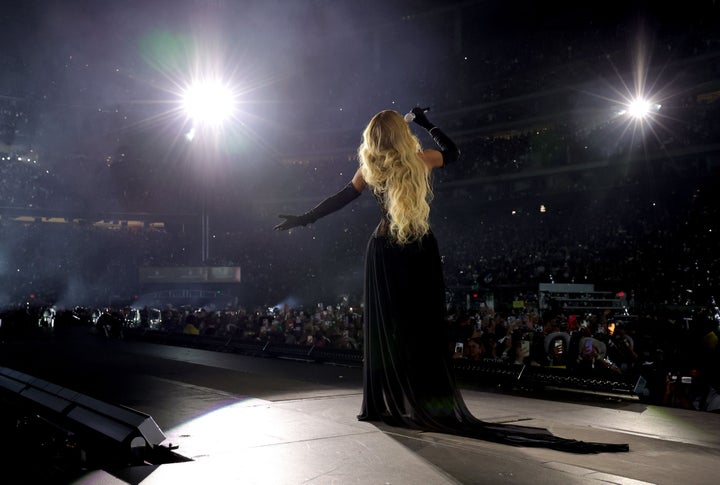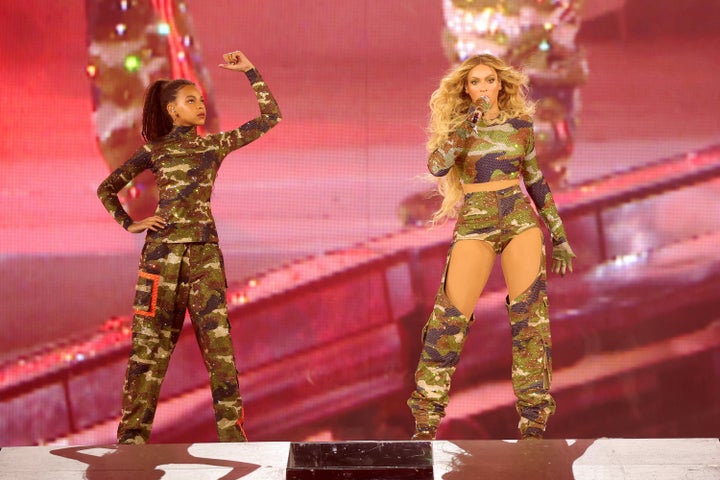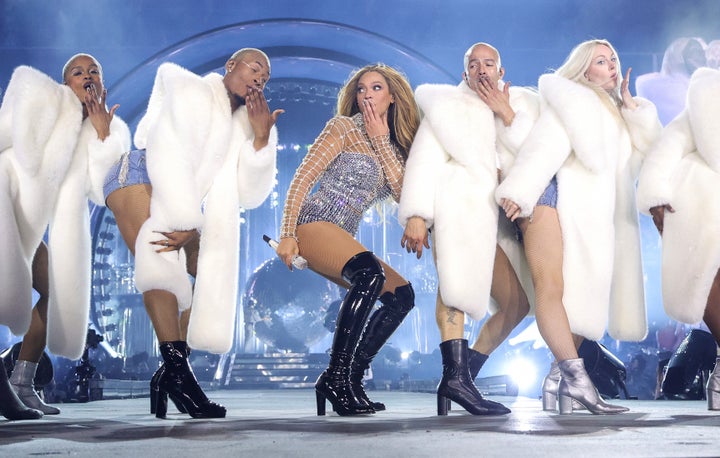‘Renaissance: A Film by Beyoncé’ Is A Love Letter To The Beyhive
If this is only Act One, we can’t wait to see what the singer’s next two acts hold.
After weeks of teaser trailers and speculation, the long-awaited “Renaissance: A Film by Beyoncé” premieres globally on Friday.
On Thursday, I filed into my local theater almost 40 minutes before showtime, a miracle for someone as chronically late as myself. Decked out in all black, I tried my best to adhere to Beyoncé’s requested “cozy opulence” theme on a budget, wearing a Renaissance World Tour shirt, Ivy Park sweatpants and a classic logo hoodie from the athleisure line’s 2016 collection.
Amid the countless fashionable fans in attendance, the excitement and anticipation was palpable. We hyped up each other’s outfits, debated which merch to buy and spread the word that, yes, we would be reviving the famous “mute challenge” during her performance of “Energy.” The Renaissance World Tour was my first time seeing Beyoncé live, perched in the nosebleeds of the MetLife Stadium in New Jersey. I knew the film would provide a much closer, more intimate lens to view the tour, both literally and figuratively, so I scrambled to buy tickets.
“Renaissance: a Film by Beyoncé” is not just a concert movie or a backstage pass into the psyche of the world’s greatest living entertainer. The film is a love letter to the Beyhive, Beyoncé’s fanbase, and the community — from Uncle Johnny to Blue Ivy Carter and beyond — that became an avenue for liberation.
“Renaissance means a new beginning and a rebirth,” she said in the film. “After all that we’ve been through in the world, I feel like everyone needs… a safe space to connect and be in community together.”

“It’s so many different bees in this hive,” the singer said in the film, rattling off the truck drivers, stage designers, dancers and more who crafted the tour experience across 56 stops. “It’s more than a concert. It’s a culture, it’s a state of mind, it’s a fantasy dream come true.”
In the “Renaissance” film, the Grammy winner’s unflinching dedication to excellence juxtaposes her humanity, struggles, flaws and all, ultimately showcasing the freedom she has harnessed along the way.
The movie begins with Beyoncé’s birthday performance on Sept. 4 at SoFi Stadium in Inglewood, California. After the opening ballad, “Dangerously in Love,” the 42-year-old pauses to deliver a moving, emotional speech on stage thanking all who have supported her throughout her 27-year career. She gently pats the tears that stream down her face, preserving her picture-perfect makeup. As she slowly ushers in the uptempo tracks from the “Renaissance” album, cameras pan across the crowd, showcasing fans belting the lyrics in unison.
Be it the vocals, costuming or choreography, the seamless editing and visual transitions point to the precision and intention that flow through every aspect of Beyoncé’s performances. In one frame, mid-strut, she is seen in her latest custom Loewe ensemble. In another, without skipping a single beat, the music icon is wrapped in a campy catsuit from Emilio Pucci. As the movie progresses, we get to see the inner workings of the highest-grossing tour of the year and all those who mobilized around it, coordinating outfits, crafting posters and chanting lyrics together. The “Renaissance” is our spiritual revival.

With this film, fans can marvel at Bey’s journey, discipline and the execution of her vision. She is meticulous and methodical but still a human being, subject to some of the same concrete and abstract limits that we all are. Despite the bouts of sinusitis and bronchitis she battled, the audio malfunction that paused her show in Glendale, Arizona, and her knee surgery one month prior to tour rehearsals, Beyoncé always returned to the stage with even more fervor. After three hours in the theater, your tears will have run dry. Your words will certainly be insufficient to describe what you’ve just witnessed onscreen, and your spirit will feel nothing short of energized.
As her director of choreography, Fatima Robinson, said, “Beyoncé is the director of this show,” involved in every single nitty, gritty detail of the Renaissance World Tour. Her awe-inspiring, unrivaled work ethic commands attention and respect, but even now, she still has to demand it.
“Being a Black woman,” Beyoncé notes at one point on camera, “the way people communicate with me is different. Everything is a fight… Eventually, they realize this bitch will not give up.” She’s not deflated by imperfection or nonsensical pushback; she just goes harder.
Recalling memories of seeing her heroes perform live, Bey says that she understands the power of the stage, which only strengthens the adamance in her requests: pare back the lighting and pyrotechnics, find a wider camera lens, simplify the stage visuals. “Mom, you’re wasting your time over fingers!” said the Hive’s favorite “manager” Blue Ivy, at one point in the film, scolding her mother for fixating on the inflatable torso during “America Has A Problem.” But the veteran entertainer held her ground, explaining that she didn’t want the audience to be distracted from the music.

Like mother, like daughter, Blue Ivy is vocal and persistent. When Beyoncé considered cutting “Diva” from the tour’s setlist, her eldest daughter pleaded with her to keep it in, resulting in a genius “Just Wanna Rock” mashup and hilarious TikTok videos. Moreover, her firstborn daughter’s determination gave us the best part of the Renaissance World Tour: Blue dancing alongside Bey during “My Power” and “Black Parade.” After the anti-Blackness that was hurled online at Blue as a baby, to see thousands of concertgoers rally around the young performer felt restorative. Fans replicated that love for her during the premiere as cheers boomed and echoed through the theater when she made her appearance on screen.
Blue’s path to improvement as a performer was not one she embarked on alone. The touring family, namely dance co-captain Amari Marshall, spurred her growth. Tina Knowles lauded Marshall as her grandchild’s “stage momma,” and in the film, Bey said she’d trust her to take care of Blue. Dancers such as Carlos Irizarry, Honey Balenciaga, Darius Hickman and others gave a brief insight into what this opportunity meant for them personally; “trapllet” dancer Trinity Joy Sanders went viral online and, within months, landed her first professional gig working for Beyoncé. Drawn to her tenacity and rawness, Bey knew who she wanted and took a chance on her.
Without the tour family, the singer makes it clear to viewers of the film that there would be no Renaissance World Tour. Without the Black queer community, there would be no “Renaissance” album, period. LGBTQ+ icons and Black ballroom legends such as Kevin Aviance, Ts Madison, and Kevin JZ Prodigy, “the heartbeat of the Renaissance Tour,” received their overdue flowers in the movie.
“I am who I am. Either you take me or you don’t. I spent so much of my life as a people pleaser and finally, I don’t give a fuck. I have nothing to prove to anyone at this point.” – Beyoncé, Mother of the House of Renaissance
The purpose of “Renaissance” was to celebrate unrecognized, unsung heroes and, in Bey’s words, to “use art to celebrate people’s differences.” She sought to create a space where “everyone is free, and no one is judged.” With bold anthems like “Church Girl” and “Break My Soul,” Beyoncé conveyed that perfectly.
She also honors the person who modeled fearlessness, none other than her late Uncle Johnny, by releasing the film on the 35th World AIDS Day. In the movie, Beyoncé wears the final dress he designed for her before his passing. When high fashion labels shunned Destiny’s Child, rejecting the idea of dressing Black country, curvy girls, Uncle Johnny and Tina Knowles stepped in. “Fashion saved my family,” Knowles said, recalling how integral it was to their survival.
Crediting Uncle Johnny with being the first person to expose her to house music, Bey said she often reflects on how challenging life must have been for him as a Southern Black gay man born in the 1950s. Nonetheless, her mother noted that her uncle would always leave a place better than when he came. When she looked into the Renaissance World Tour crowd, Knowles said, she saw people who reminded her of him.
From the crowd to the crew, all these people, these bees in the hive, have contributed to what we know and love as Beyoncé’s “Renaissance.” In the credits, she thanks everyone, from the drivers to the designers, stylists, producers, editors and more. No one in the hive gets left behind. “Renaissance” is not just the external product but what Beyoncé has acquired through this work.

By channeling her vulnerability and centering community, she radiates joy, exudes confidence and oozes shit-talking swagger, especially evident in her latest single, “My House,” which plays during the closing credits. Toward the film’s end, Bey reflects upon her career and life, admitting that while she thought her 30s were the pinnacle of pleasure, the 40s are only getting better. At the end of the tour, her husband Jay-Z asks Bey how she’s feeling. She responds with “proud,” proclaiming that she feels free.
Beyoncé is not beholden to any institutions or person’s expectations but her own. As she sings in “Alien Superstar,” she continues to set the bar, the standard for excellence. No Grammy nor singular award can ever define or erode who she is.
“I am who I am. Either you take me, or you don’t,” she says in the film. “I spent so much of my life as a people pleaser, and finally, I don’t give a fuck. I have nothing to prove to anyone at this point.”
If this is only Act One, I cannot wait to see what the next two hold.
Credit: Source link